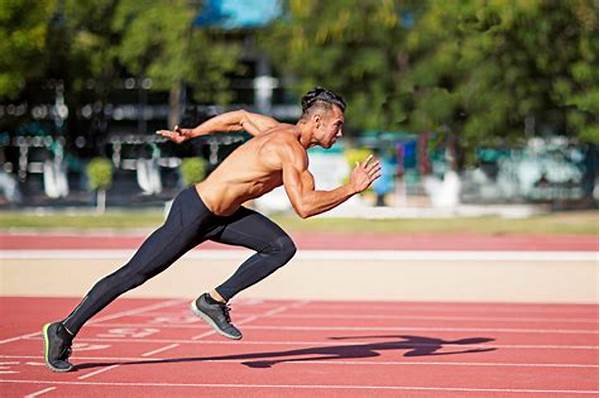Physical Training For Sprinters

In the fast-paced world of athletics, where victory is often determined in fractions of a second, sprinters must be at the pinnacle of human performance. Physical training for sprinters isn’t just about raw speed; it’s about explosive power, rock-solid endurance, and precise technique. Imagine being able to slice through air resistance like a finely-tuned sports car on a racetrack! How do top athletes like Usain Bolt and Shelly-Ann Fraser-Pryce achieve their world-beating speeds? The secret lies in a specialized training regimen tailored to sprinters.
Read More : Live Coverage Of The Italian Serie A League Via Sky Sports Live Football
Sprinters are not born; they are meticulously crafted through hours of dedicated training and fine-tuning. It’s not just a workout; it’s an art form. Building blazingly fast sprint capabilities requires more than just a desire to win—it demands a deep understanding of biomechanics, nutrition, and mental toughness. Whether you’re a seasoned athlete or someone aiming to shave a few milliseconds off your personal best, this guide will illuminate the path to improved performance. Read on for a mix of humor, tips, stories, and expert opinions that dive deep into the world of sprint training.
The Importance of Strength in Sprinting
Physical training for sprinters starts in the gym. While it might be tempting to focus solely on running track exercises, strength training is paramount. Strengthening key muscle groups, particularly the glutes, hamstrings, quads, and calves, can improve power output and acceleration.
The Role of Plyometrics
Imagine bouncing as a supercharged pogo stick—that’s what plyometrics can do for sprinters. Plyometric exercises, which include box jumps and bounding drills, develop explosive power. This increased power translates into quicker start times and swifter pace maintenance.
Flexibility and Its Benefits
Think of flexibility as the oil that lubricates your sprinting engine. Stretching routines and dynamic warm-ups increase flexibility and range of motion, preventing injuries and enhancing performance. A flexible sprinter can move more efficiently and with less resistance, leading to better speeds.
Cardiovascular Conditioning and Sprinting
While it might seem counterintuitive, cardiovascular endurance is crucial for sprinters. This type of conditioning helps in recovery times during training and competitions, ensuring that a sprinter can repeatedly perform at peak levels.
High-Intensity Interval Training (HIIT)
One popular method is High-Intensity Interval Training (HIIT). These short, intense bursts of activity followed by a brief rest period improve not just endurance, but also the speed at which a sprinter can run repeatedly. Sprinters who integrate HIIT workouts often find themselves boasting quicker recovery times and more explosive on-track performances.
Importance of Diet and Nutrition
The right fuel can make or break an athlete. Physical training for sprinters is not complete without a focus on nutrition. Carbohydrates provide the necessary energy, while proteins are crucial for muscle repair and growth. A balanced diet ensures optimal energy levels and recovery sessions, keeping injuries at bay.
Hydration’s Role
Just like a dehydrated plant wilts, so does a dehydrated athlete. Proper hydration before, during, and after workouts ensures that muscles function optimally and that recovery processes are streamlined.
Mental Preparation and Sprinting
Finally, no physical prowess is complete without the mental fortitude to match. Sprinters require immense concentration and the ability to maintain composure under pressure. Visualization techniques, mindfulness practices, and setting achievable goals contribute to a sprinter’s success.
Read More : The Role Of Psychology In Sprinting
The Power of Visualization
Before each race, visualizing the perfect start, pace, and finish can mentally prepare an athlete. This focused mindset can often be the difference between gold and silver.
Building Confidence
Confidence-building exercises, like reviewing past performances and acknowledging improvements, help sprinters overcome self-doubt, ensuring that when they step onto the track, they are mentally equipped to perform.
—Detailing Physical Training for Sprinters
- Strength Training: Essential for improving acceleration and top speed.
- Focus on exercises like squats, deadlifts, and lunges to build leg and core strength.
- Plyometrics: Enhances explosive power, crucial for quick starts.
- Include exercises like box jumps and depth jumps.
- Flexibility Routines: Critical for injury prevention and performance.
- Incorporate dynamic stretches and yoga to increase mobility.
- Diet and Nutrition: Fuels the body for peak performance.
- Balance intake of carbohydrates, proteins, and fats.
- Mental Training: Sharpens focus and enhances performance under pressure.
- Utilize visualization and goal-setting techniques.
- Cardiovascular Conditioning: Improves recovery times and sustains high performance.
- Implement HIIT sessions to boost endurance.
—
Points on Physical Training for Sprinters
- Balanced Training Program: A mix of strength, speed, and endurance exercises.
- Consistency is Key: Regular training routines lead to steady improvements.
- Customized Nutrition Plans: Tailor diets to specific energy and recovery needs.
- Injury Prevention Strategies: Through proper warm-ups, stretching, and corrective exercises.
- Mindset and Motivation: Fuel the desire for success and resilience in competition.
Summary of Physical Training for Sprinters
In conclusion, physical training for sprinters is a multi-faceted approach that begins in the gym and stretches far beyond the track. Strength, flexibility, cardiovascular conditioning, and mental toughness are the cornerstones of an effective sprint training program. The right blend of these components will not only dagelan4d enhance raw speed but also improve efficiency and agility, ultimately pushing you closer to that personal best.
The journey of a sprinter, much like the races themselves, is thrilling, challenging, and packed with moments of triumph and learning. By adopting a comprehensive and customized training regimen, aspiring sprinters can transform their capabilities, inch closer to their full potential, and perhaps, one day, become the next legendary name in track and field. Whether you’re a seasoned athlete or just starting, the right training program can make all the difference in sprinting towards success.



